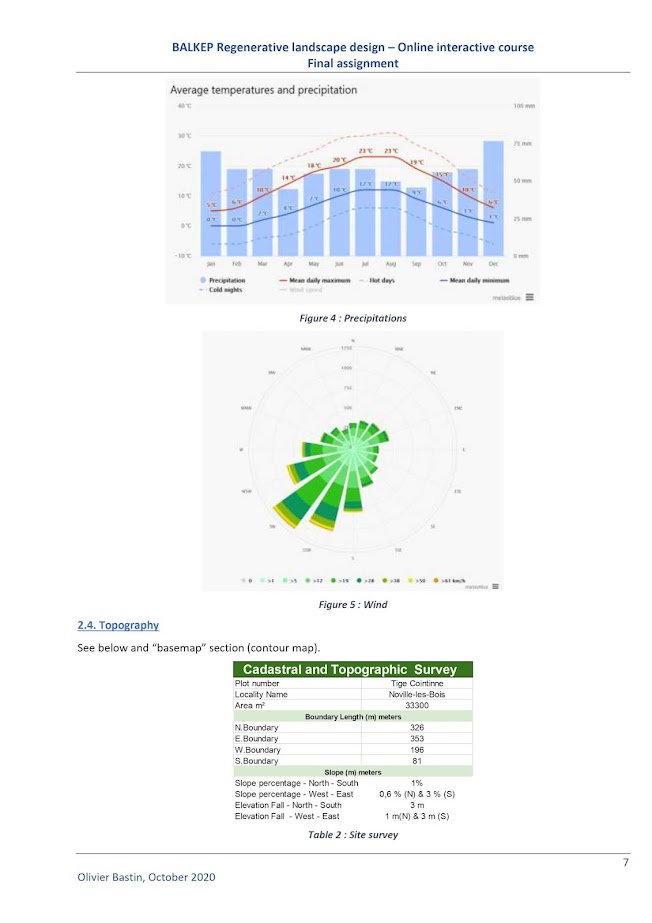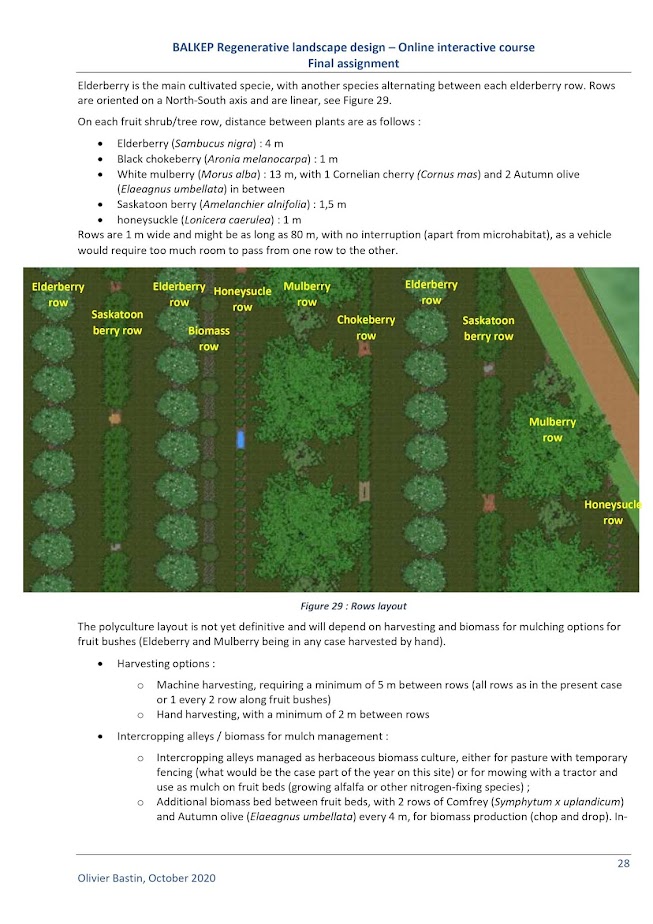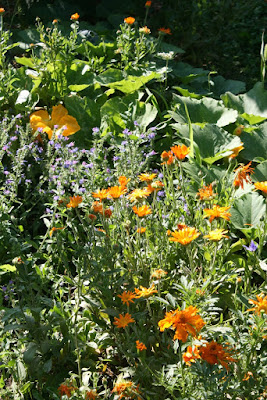During this post, we're going to take a look at some trees that have edible leaves. Since trees can produce prolific amounts of leaves, there is a great opportunity to access a generous supply of greens, with relatively minimal effort when compared to cultivating annual greens and salad leaves.
 |
| Trees with Edible Leaves |
We include the below species in all of our forest garden and polyculture landscapes and are always on the lookout for new species so if you know of any trees or shrubs with edible leaves please let us know in the comment section below. So here our four of our favourite trees with edible leaves.
Linden - Tilia spp.
Tilia is a genus of about 30 species of trees or bushes, native throughout most of the temperate Northern Hemisphere. More commonly referred to as Linden or Lime, this tree is not to be confused with Citrus medica, the tree that produces actual lime fruits.
Tilia cordata - Small Leaved Lime and
Tilia platyphyllos - Large Leaved Lime are probably the most well known in Europe, although it can be difficult to differentiate between them sometimes as they tend to hybridize, resulting in
Tilia vulgaris - Common Lime. Both trees and the hybridized form have edible leaves, in addition to producing a flower that is much valued as a herbal tea.
Tillia sp.
Overview: Lime or Linden tree is a deciduous tree that can grow up to 45m at a medium rate. This impressive height gives the tree a sense of stature and beauty, making it a good choice for the upper canopy of a forest garden or perfect a s a stand alone ornamental. It is often grown in parks. Beautiful flowers bloom for around 2 weeks between June - July, and for a few days fill the air with their rich scent. Seeds ripen in October. The species is hermaphrodite and is pollinated by Bees. It is noted for attracting wildlife and attracts aphids who deposit their honeydew droppings on the leaves in the summer (an extra treat for the forager!). Prefers moist soil and can tolerate strong winds.
Edibility: Listed on the
PFAF website as 5/5. The heart shaped young leaves of the Linden tree are highly edible and are great in salads. They have a mild flavour which is considered better than lettuce, and serve well to bulk out salads. Flowers not only make a delicious tea, but have medicinal properties too, reportedly soothing anxiety and reducing fever. The sap of the Linden tree is sweet and can be made into a syrup.
Where and When to Harvest: The leaves are best when eaten young in May, but fortunately because of the tree's suckering nature, young leaves can be found pretty much thoughout the whole summer as the tree puts out new growth on the suckers at the base. Flowers should be harvested a day or 2 after opening when they are at their most potent. Can be spread out on brown paper to dry, ideally in a well ventilated and dark room
Top Tip: Look for the young leaves that are shiny, as these have the best flavour and texture.
Want to learn how to design, build and manage regenerative landscapes? Join us on our Regenerative Landscape Design - Online Interactive Course. We look forward to providing you with the confidence, inspiration, and opportunity to design, build and manage regenerative landscapes, gardens, and farms that produce food and other resources for humans while enhancing biodiversity.
You can access the course material at anytime and join the live sessions and interactive forums that run from May - Oct every year. All members of the Bloom Room receive a 500 EUR discount. To take up this offer all you have to do is become an annual subscribers to our Substack and register here with the promo code BLOOM.
I look forward to you joining !
Hawthorn - Crataegus monogyna
C. monogyna is a widely known shrub or small tree belonging to the Rosaceae family. It's showy, white flowers often bloom on May day, marking the height of springtime in a stunning way. Historically, Hawthorn has an established reputation of being highly effective in regulating blood pressure, and it's an interesting plant to the forager and perhaps somewhat surprisingly, can be a wonderful addition to the edible forest garden.
Edible Fruits of Crataegus sp.
Overview: Hawthorn is a deciduous shrub or small tree growing to 6m in height at a medium rate. The beautiful flowers have inspired artists for years, and they make an excellent hedging plant, providing valuable food for a variety of insects. Blooms in May an impressive display and the species is hermaphrodite with flies and midges being the main pollinators. Seeds ripen from October to November. Grows in a variety of soil types and can tolerate drought.
.
Edibility: Listed on the
PFAF website as 3/5. The young leaves of the Hawthorn can be used in salads. They are quite mild but also succulent. May also be dried for tea. Flowers can be added to the salad bowl. Although the berries of the Hawthorn known as 'Haws' are edible and quite tasty, in my opinion it's not worth the effort because there is little flesh in relation to the seed. However, Hawberries are full of pectin and so are very useful to help jams and jellies set. Medicinally, Hawthorn has a reputation as being an excellent 'cardiac' plant.
Where and When to Harvest: The leaves can only really be eaten when they are very young, around the end of April, when still make a perfectly acceptable spring green for salads. Flowers should be harvested freshly when they bloom in early May. The Hawberries can be harvested when fully ripe and ideally after the first frost. They taste a little like apples.
Top Tip: Watch out for the thorns on the branches when you harvest the leaves in spring!.
Welcome to our
Online Store where you can find Forest Garden/ Permaculture plants, seeds, bulbs and
Polyculture multi-packs along with digital goods and services such as
Online Courses, Webinars,
eBooks, and Online Consultancy. We hope you enjoy the store and find something you like :) It's your purchases that keep our Project going. Yuu can also find our full list of trees. shrubs and herbs for forest gardens on our
website here
Morus alba - White Mullbery
If you are a follower of our work you will know how much we love our Mulberries! For a detailed blog post about Mulberries see here. White Mulberry cultivation has a long and rich history dating back thousands of years ago as a requirement for silkworm rearing. The species is native to northern China and India, and is widely cultivated and naturalized elsewhere. The berries are easily recognizable, but a less well known is the fact that the leaves are also edible.
Morus alba leaves
Overview: Mulberry is a deciduous tree growing to 18m in height at a medium rate. The tree can take an attractive, rounded form and has excellent polyculture potential as it tolerates light shade. It is in flower in May and the fruit ripens mid - late June in our area. The species is monoecious and self fertile, although a huge magnet for wildlife, who love to feast on the succulent fruit. Prefers well drained soil and can tolerate drought.
Edibility: Listed on the
PFAF website as 4/5. The young leaves and shoots of the Mulberry tree are very edible, but unlike the trees previously profiled they need to be cooked as a vegetable. They can be
cooked in a similar way to spinach, wilted down and seasoned with soy sauce for use in a stir fry. Very rich in carotene and calcium. The leaves can also be stuffed with a rice and spice mixture in the same way as grape leaves. There are some reports of the bark of Mulberries being used as a thickener in soups. Fruit is simply delicious, and can also be dried.

According to Issei Shinagawa from Hong Kong a cup of Mulberry leaf tea a day will turn your grey hairs black as well improve your general health. All fresh leaves are fine to use for the tea. You can simply run your hand down a branch and strip all the leaves, they come off really easily. The leaves can be dried whole or cut into strips. I dried some cut leaves on our kitchen table by a sunny window and they were dry within a day and half.
Morus alba leaves drying for tea
Simply crumble a few leaves into a cup and pour on the hot water and you have a very decent tasting cuppa.
Where and When to Harvest: The leaves and shoots should be harvested in late April or early May as the tree starts to shoot out. Again, the younger leaves have the best flavor and texture. and it is the tips of that new growth that are good to eat. Harvest only as far down as the stem can easily be snapped off.
Top Tip: The best mulberry greens are the tips of actively growing shoots from trees that have been cut back, so you could consider maintaining a Mulberry tree in your edible landscape in this way!
Want to learn more about Regenerative Landscape Design? Join The Bloom Room!
The Bloom Room is designed to create a space for more in-depth learning, for sharing projects and ideas, for seeking advice and discovering opportunities.
Ultimately, it aims to build a more intimate, interactive, and actionable relationship between members, a way for the Bloom Room community to support each other’s projects and learning journeys, and to encourage and facilitate the design, build, and management of more regenerative landscapes across our planet.
What you can expect as a member of the Bloom Room
As a member of the Bloom Room you can expect;
Access to an interactive forum where you can ask questions, direct what type of content you would like to see as well as share your own content and projects.
Live sessions featuring general Q&A and tutorials on design software for creating and presenting polycultures.
Full Access to all of the content on Substack
Future opportunities to join our Global Regenerative Landscape Design and Consultancy Service, with potential roles for those with the will and skill to join our design team.
An opportunity to take part in the group ownership of a Regenerative Landscape. You will find more details on that here.
Become a paid subscriber to our Substack to join. The annual subscription is currently $70 and the monthly subscription is $7 (monthly subscription excludes discounts for products and services) . You can join here, we look forward to meeting you!
Hardy Rubber Tree - Eucommia ulmoides
As the name suggests, rubber can in fact be made from this tree but it is not widely used as the extraction process is too complicated to make it economically viable. It's a good urban tree, low maintenance and tolerates air-pollution, but it's also a surprisingly good choice for an edible landscape because it is rather attractive and its leaves are also edible.
Overview: Hardy Rubber Tree is a deciduous tree growing to 18m in height at a fast rate. Native to China, as the name suggests, it is possible to produce rubber from the sap. The tree is very low maintenance and very attractive with an unusually dark green colour developing in the summer. It is in flower in April and the species is is dioecious. It grows in most soils and prefers full sun/partial shade.
Edibility: Listed on the PFAF website as 1/5 without much information other than the leaves can be eaten. I couldn't find much information at all about the use of this plant in the kitchen, but we are growing the tree in Aponia, our market garden, and I regularly pick a few leaves as I pass the trees in the garden and the best way I explain the experience is like chewing nettle flavored chewing gum. You can see in the photo below the latex within the leaf tissue that provides a chewy texture to the leaf.
Where and When to Harvest: The best time to harvest the leaves for eating is in the early spring when the leaves are emerging. Later in the growing season the leaves toughen up and become more bitter.
Top Tip: If you prune sections of the plant during the growing season it will promote new growth so you can maintain a source of fresh leaves.
***Take Care when Eating Wild Plants and Plants you are not familiar with***
Although these plants have been used for centuries in the kitchen by some, as with any plants we consume, it's worth doing your own research first. For example, there are some reports of toxicity with Lime flowers and Mulberry leaves, but many people report no issues at all. We have certainly been drinking Lime flower tea for decades with no adverse effects.
Other Woody Perennials with Edible Leaves
Vitis vinifera - Grapevine - Most people are familiar with stuffed vine leaves - 'Сарми' in Bulgaria or Dolmades in Greece - a very popular dish here in the Balkans.
Here are a few more trees and shrubs with edible leaves
Support Our Project
If you appreciate the work we are doing you can show your support in several ways.






















































-page-001.jpg)